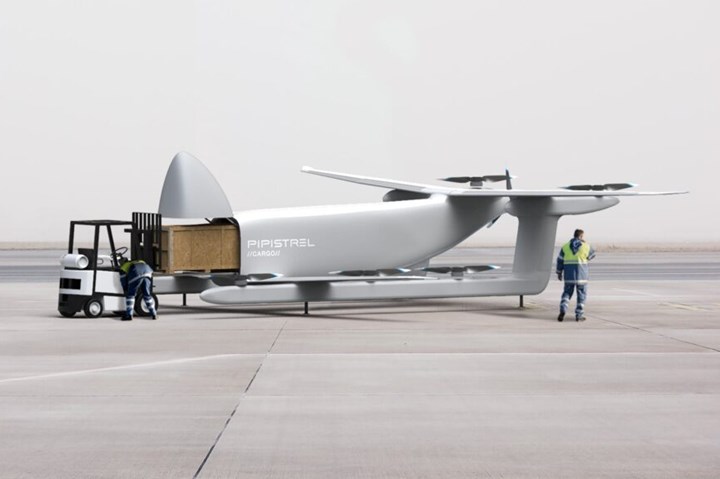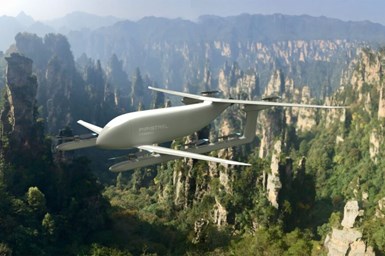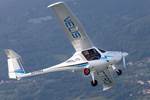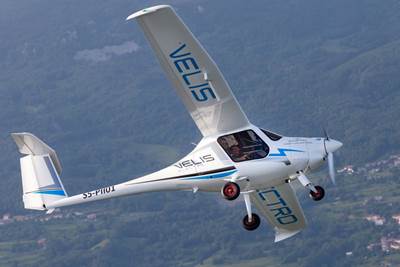Pipistrel accepts orders for Nuuva series eVTOL aircraft
The Nuuva V300 is a long-range autonomous eVTOL UAV for logistics and aerial cargo delivery. It is considered more economical, safe and reliable compared to conventional helicopters.

An artistic rendition of the Nuuva V300 loading with a forklift. Photo Credit: Pipistrel
Small aircraft designer and manufacturer, (AjdovšÄŤina, Slovenia) presented on Sept. 1 the Nuuva V300 as the flagship model of the Nuuva series of unmanned air vehicles (UAVs), and has begun accepting orders. According to Pipistrel, this aircraft embodies the company’s vision to disrupt aerial cargo transportation by commercializing the use of electrical vertical take-off and landing (eVTOL) vehicles. Customizable, the long-range autonomous aircraft is said to be able to carry up to 460 kilograms, is easy and economical to operate and offers the efficiency and reliability of electric powertrains. Entry into service is planned for the second half of 2023.
According to Pipistrel, the Nuuva family combines the best of both airplane and helicopter air cargo transportation principles; the unmanned eVTOL capability enables it to enter spaces airplanes cannot, and its hybrid configuration allows it to operate at a fraction of the cost of a helicopter on an equivalent mission. The Nuuva V300, says Pipistrel, is targeting to deliver ten times the improvement in economics to the operator.

An artistic rendition of the aircraft in flight
The large cargo compartment accepts up to three Euro-pallets (EPAL) that are reportedly easy to load with a regular forklift. The Nuuva V300 then flies a preloaded flight plan fully autonomously, controlled by a digital flight control system. Continuous communication allows the ground operator, who manages the vehicle, to have complete control in case of changes or cancellation of the flight.
Pipistrel says the aircraft takes off and lands using eight independent battery-powered Pipistrel E-811 electric engines, already Type Certified (TC). Further, the whole system is safeguarded by an integrated health self‑monitoring system that alerts of any potential malfunction before they occur, increasing reliability and safety. Further, Nuuva V300’s batteries can be charged by plugging-in to a SkyCharge by Pipistrel and Green Motion charging station.
In addition, the aircraft has improved fuel economy and low maintenance costs via an internal combustion engine in the aft fuselage, and a tandem-wing configuration with fly-by-wire control surfaces are said to boost the aerodynamic efficiency and reduce the landing footprint of the vehicle.
Pipistrels points to the aircraft’s ability to be customized for a wide range of missions. For operators that prioritize longer range, the vehicle’s payload capacity and anti-ice capabilities can be traded off for more usable fuel, and an ability to transport 50-kilogram payload for as far as 2,500 kilometers, all this without compromising the ability to take-off and land vertically from altitudes as high as 8,000 feet. At lower take-off altitudes and with shorter mission requirements, the company says the payload can be increased to up to 460 kilograms.
Included in the Nuuva family is the Nuuva V20. The smaller of the family aircraft, the V20 is said to share the same architecture and advantages of the larger V300 but is designed as a lightweight cargo courier carrying payloads of up to 20 kilograms. First customers will be able to take deliveries as early as 2021.
Related Content
Plyable releases AI-powered mold design tool
Plyable continues to rid composites engineers of workflow bottlenecks through an end-to-end automated system — from mold design to quotation to manufacturing fulfillment.
Read MoreFlyber launches U.K. composites manufacturing site for advanced mobility applications
The startup’s design automation and composite material layup and curing technologies target lightweighting for aerospace, UAVs, eVTOL and high-performance mobility platforms.
Read MoreBroetje-Automation demonstrates rCF placement via AFP
Through the ScrapSeRO project, the system integrator and machine builder successfully processed recycled composites, in addition to more traditional materials, via its highly flexible Staxx One system.
Read MoreZünd, Loop Technology partner on FibreLine preforming system
Pairing Loop Technology’s automation with Zünd digital cutters provides faster cutting, less stray fibers, higher ply accuracy and more precise preforms for composite aerostructure manufacturing.
Read MoreRead Next
Velis Electro all-electric aircraft obtains type certificate
Obtained from EASA, the Type Certification furthers Pipistrel’s goal for sustainable and emissions-free aircraft.
Read MoreNext-gen fan blades: Hybrid twin RTM, printed sensors, laser shock disassembly
MORPHO project demonstrates blade with 20% faster RTM cure cycle, uses AI-based monitoring for improved maintenance/life cycle management and proves laser shock disassembly for recycling.
Read MoreCeramic matrix composites: Faster, cheaper, higher temperature
New players proliferate, increasing CMC materials and manufacturing capacity, novel processes and automation to meet demand for higher part volumes and performance.
Read More












